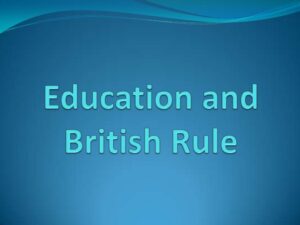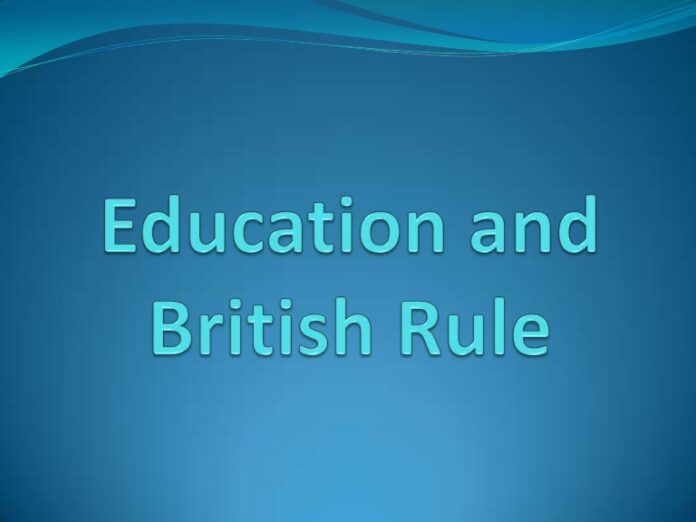Education System In India During British Rule NCERT Notes: [Modern Indian History]

NCERT notes on significant subjects for the UPSC common administrations test. These notes will likewise be valuable for other cutthroat tests like financial PO, SSC, state common administration tests, etc. This article discusses the Education System in India during British Rule.
Current training started in India under British standards. Prior to the British, India had its own instructive frameworks like the Gurukulas and the Madrassas. The East India Company, during their initial 60 years of rule didn’t really like the training of those they managed in India. (Indeed, even in England, general schooling happened at a lot later stage.)
Up-and-comers can likewise download the notes PDF from the connection given underneath.
Three specialists of current training in India
-
The British Government (East India Company)
-
Christian evangelists
-
Indian scholarly people and reformers
Advancement of the current instruction
Advancement of Modern Education
-
The organization needed some informed Indians who could help them in the organization of the land.
-
Additionally, they needed to comprehend the nearby traditions and laws well.
-
For this reason, Warren Hastings set up the Calcutta Madrassa in 1781 for the educating of Muslim law.
-
In 1791, a Sanskrit College was begun in Varanasi by Jonathan Duncan for the investigation of the Hindu way of thinking and laws.
-
The ministers upheld the spread of Western schooling in India fundamentally for their converting exercises. They set up numerous schools with instruction just being a necessary chore which was Christianising and ‘edifying’ the locals.
-
The Baptist minister William Carey had come to India in 1793 and by 1800 there was a Baptist Mission in Serampore, Bengal, and furthermore various elementary schools there and in close by territories.
-
The Indian reformers accepted that to stay aware of times, an advanced instructive framework was expected to spread judicious reasoning and logical standards.
-
The Charter Act of 1813 was the initial move towards instruction being made a goal of the public authority.
-
The demonstration authorized an amount of Rs.1 lakh towards the training of Indians in British-controlled India. This demonstration likewise gave a stimulus to the ministers who were allowed the official to come to India.
-
Yet, there was a parted in the public authority over what sort of schooling was to be offered to the Indians.
-
The orientalists favored Indians to be given customary Indian instruction. Some others, in any case, needed Indians to be instructed in the western style of schooling and be shown western subjects.
-
There was likewise another trouble in regards to the language of guidance. Some needed the utilization of Indian dialects (called vernaculars) while others favored English.
-
Because of these issues, the amount of cash designated was not given until 1823 when the General Committee of Public Instruction chose to give oriental schooling.
-
In 1835, it was concluded that western sciences and writing would be conferred to Indians with the help of English by Lord William Bentinck’s administration.
-
Bentinck had delegated Thomas Babington Macaulay as the Chairman of the General Committee of Public Instruction.
-
Macaulay was a vigorous anglicist who had supreme scorn for Indian learning of any sort. He was upheld by Reverend Alexander Duff, JR Colvin, and so forth
-
On the orientalists were James Prinsep, Henry Thomas Colebrooke, and so forth
-
Macaulay minutes allude to his proposition of instruction for the Indians.
-
As per him:
-
-
English instruction ought to be bestowed instead of conventional Indian learning in light of the fact that the oriental culture was ‘inadequate’ and ‘unholy’.
-
He trusted in training a couple of upper and working-class understudies.
-
Over the span of time, schooling would stream down to the majority. This was known as the invasion hypothesis.
-
He wished to make a class of Indians who were Indian in shading and blood yet English in taste and association.
-
-
In 1835, the Elphinstone College (Bombay) and the Calcutta Medical College were set up.
Wood’s Despatch (1854)
-
Sir Charles Wood was the President of the Board of Control of the organization in 1854 when he sent a despatch to the then Governor-General of India, Lord Dalhousie.
-
This is known as the ‘Magna Carta of English schooling in India.’
-
Proposals of the Wood’s Despatch:
-
Regularize instruction framework from the essential to the college levels.
-
Indians were to be instructed in English and their local language.
-
The instruction framework was to be set up in each region.
-
Each region ought to have in any event one government school.
-
Subsidiary non-public schools could be conceded help.
-
Schooling of ladies ought to be stressed.
-
Colleges of Madras, Calcutta, and Bombay were set up by 1857.
-
College of Punjab – 1882; University of Allahabad – 1887
-
This despatch requested the public authority to assume up the liability from the schooling of individuals.
-
Appraisal of the British endeavors on training
-
In spite of the fact that there were a couple of Englishmen who needed to spread instruction for the wellbeing of its own, the public authority was mostly concerned uniquely with its own interests.
-
There was a gigantic interest for agents and other managerial parts in the organization’s working.
-
It was less expensive to get Indians instead of Englishmen from England for these positions. This was a superb intention.
-
Almost certainly it spread western schooling among Indians, yet the pace of proficiency was wretchedly low during British standard.
-
The condition of ladies’ instruction was pitiable. This was on the grounds that the public authority would not like to disappoint the universal idea of Indians and furthermore in light of the fact that ladies couldn’t by and large be utilized as assistants.
-
In 1911, the lack of education rate in British India was 94%. In 1921, it was 92%.
-
Logical and specialized instruction was overlooked by the British government.


